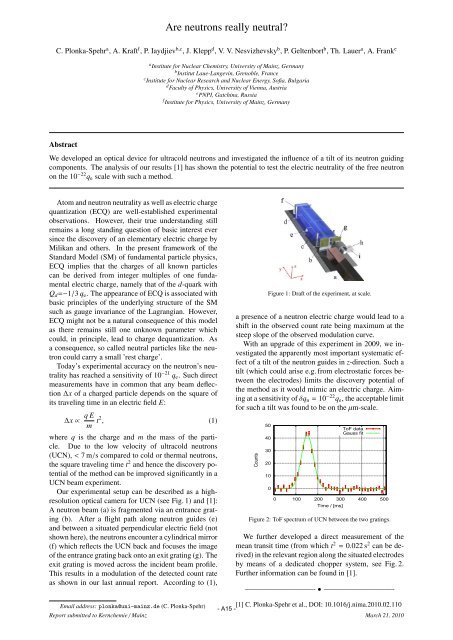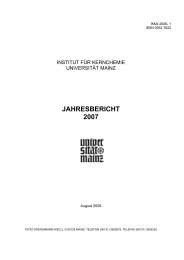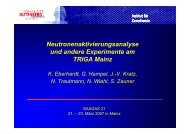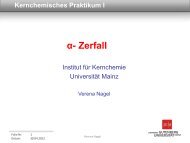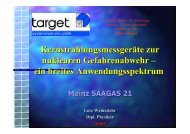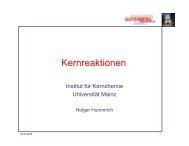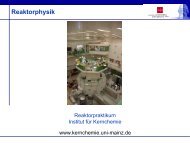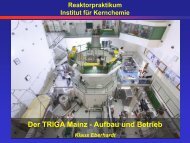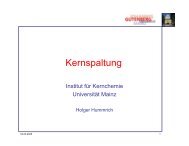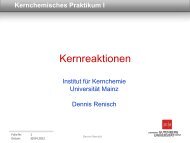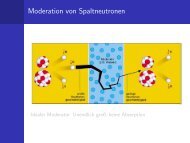institut für kernchemie universität mainz jahresbericht 2009
institut für kernchemie universität mainz jahresbericht 2009
institut für kernchemie universität mainz jahresbericht 2009
Create successful ePaper yourself
Turn your PDF publications into a flip-book with our unique Google optimized e-Paper software.
Are neutrons really neutral?<br />
C. Plonka-Spehr a , A. Kraft f , P. Iaydjiev b,c , J. Klepp d , V. V. Nesvizhevsky b , P. Geltenbort b , Th. Lauer a , A. Frank e<br />
Abstract<br />
a Institute for Nuclear Chemistry, University of Mainz, Germany<br />
b Institut Laue-Langevin, Grenoble, France<br />
c Institute for Nuclear Research and Nuclear Energy, Sofia, Bulgaria<br />
d Faculty of Physics, University of Vienna, Austria<br />
e PNPI, Gatchina, Russia<br />
f Institute for Physics, University of Mainz, Germany<br />
We developed an optical device for ultracold neutrons and investigated the influence of a tilt of its neutron guiding<br />
components. The analysis of our results [1] has shown the potential to test the electric neutrality of the free neutron<br />
on the 10 −22 qe scale with such a method.<br />
Atom and neutron neutrality as well as electric charge<br />
quantization (ECQ) are well-established experimental<br />
observations. However, their true understanding still<br />
remains a long standing question of basic interest ever<br />
since the discovery of an elementary electric charge by<br />
Milikan and others. In the present framework of the<br />
Standard Model (SM) of fundamental particle physics,<br />
ECQ implies that the charges of all known particles<br />
can be derived from integer multiples of one fundamental<br />
electric charge, namely that of the d-quark with<br />
Qd=−1/3 qe. The appearance of ECQ is associated with<br />
basic principles of the underlying structure of the SM<br />
such as gauge invariance of the Lagrangian. However,<br />
ECQ might not be a natural consequence of this model<br />
as there remains still one unknown parameter which<br />
could, in principle, lead to charge dequantization. As<br />
a consequence, so called neutral particles like the neutron<br />
could carry a small ’rest charge’.<br />
Today’s experimental accuracy on the neutron’s neutrality<br />
has reached a sensitivity of 10 −21 qe. Such direct<br />
measurements have in common that any beam deflection<br />
∆x of a charged particle depends on the square of<br />
its traveling time in an electric field E:<br />
∆x ∝<br />
q E<br />
m t2 , (1)<br />
where q is the charge and m the mass of the particle.<br />
Due to the low velocity of ultracold neutrons<br />
(UCN), < 7 m/s compared to cold or thermal neutrons,<br />
the square traveling time t 2 and hence the discovery potential<br />
of the method can be improved significantly in a<br />
UCN beam experiment.<br />
Our experimental setup can be described as a highresolution<br />
optical camera for UCN (see Fig. 1) and [1]:<br />
A neutron beam (a) is fragmented via an entrance grating<br />
(b). After a flight path along neutron guides (e)<br />
and between a situated perpendicular electric field (not<br />
shown here), the neutrons encounter a cylindrical mirror<br />
(f) which reflects the UCN back and focuses the image<br />
of the entrance grating back onto an exit grating (g). The<br />
exit grating is moved across the incident beam profile.<br />
This results in a modulation of the detected count rate<br />
as shown in our last annual report. According to (1),<br />
Email address: plonka@uni-<strong>mainz</strong>.de (C. Plonka-Spehr)<br />
Figure 1: Draft of the experiment, at scale.<br />
a presence of a neutron electric charge would lead to a<br />
shift in the observed count rate being maximum at the<br />
steep slope of the observed modulation curve.<br />
With an upgrade of this experiment in <strong>2009</strong>, we investigated<br />
the apparently most important systematic effect<br />
of a tilt of the neutron guides in z-direction. Such a<br />
tilt (which could arise e.g. from electrostatic forces between<br />
the electrodes) limits the discovery potential of<br />
the method as it would mimic an electric charge. Aiming<br />
at a sensitivity of δqn = 10 −22 qe, the acceptable limit<br />
for such a tilt was found to be on the µm-scale.<br />
Counts<br />
50<br />
40<br />
30<br />
20<br />
10<br />
0<br />
0 100 200 300 400 500<br />
Time / [ms]<br />
ToF data<br />
Gauss fit<br />
Figure 2: ToF spectrum of UCN between the two gratings.<br />
We further developed a direct measurement of the<br />
mean transit time (from which t 2 = 0.022 s 2 can be derived)<br />
in the relevant region along the situated electrodes<br />
by means of a dedicated chopper system, see Fig. 2.<br />
Further information can be found in [1].<br />
—————————- • —————————-<br />
[1] C. Plonka-Spehr et al., DOI: 10.1016/j.nima.2010.02.110<br />
Report submitted to Kernchemie / Mainz March 21, 2010


